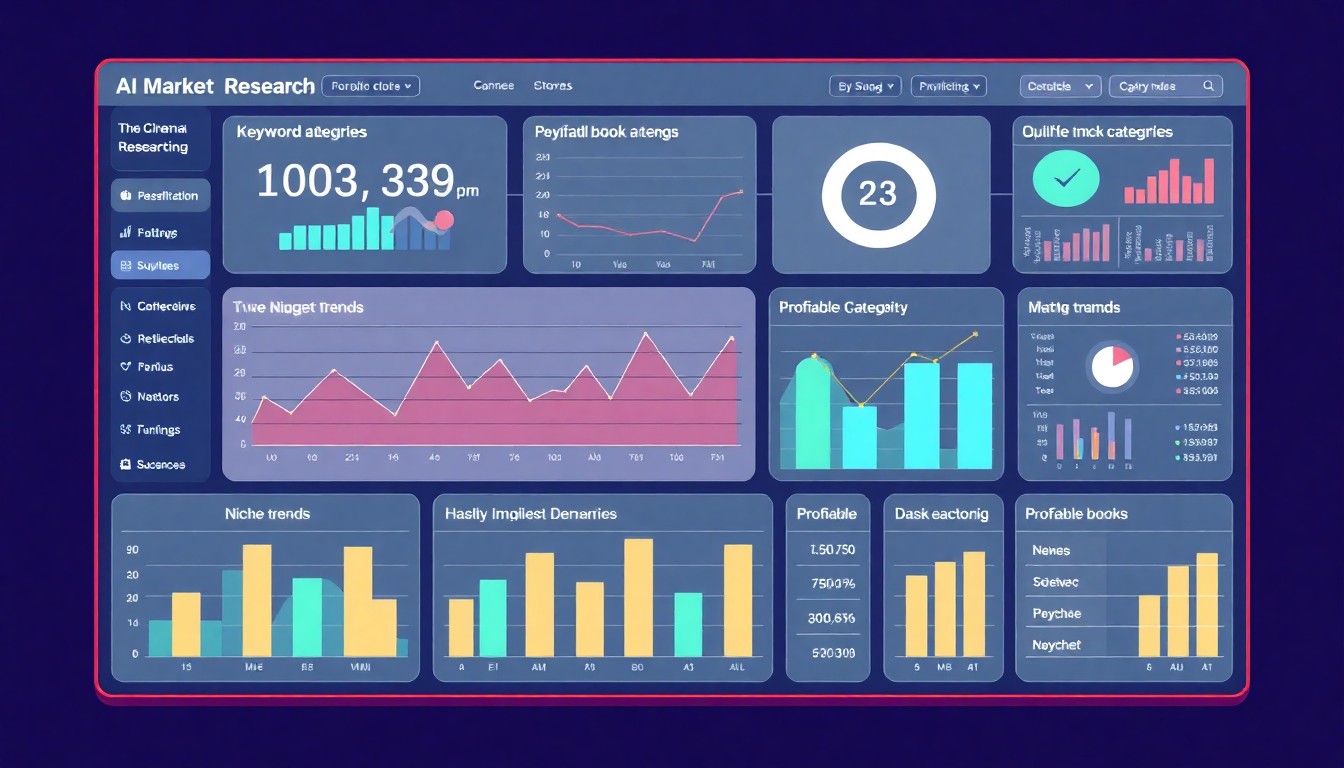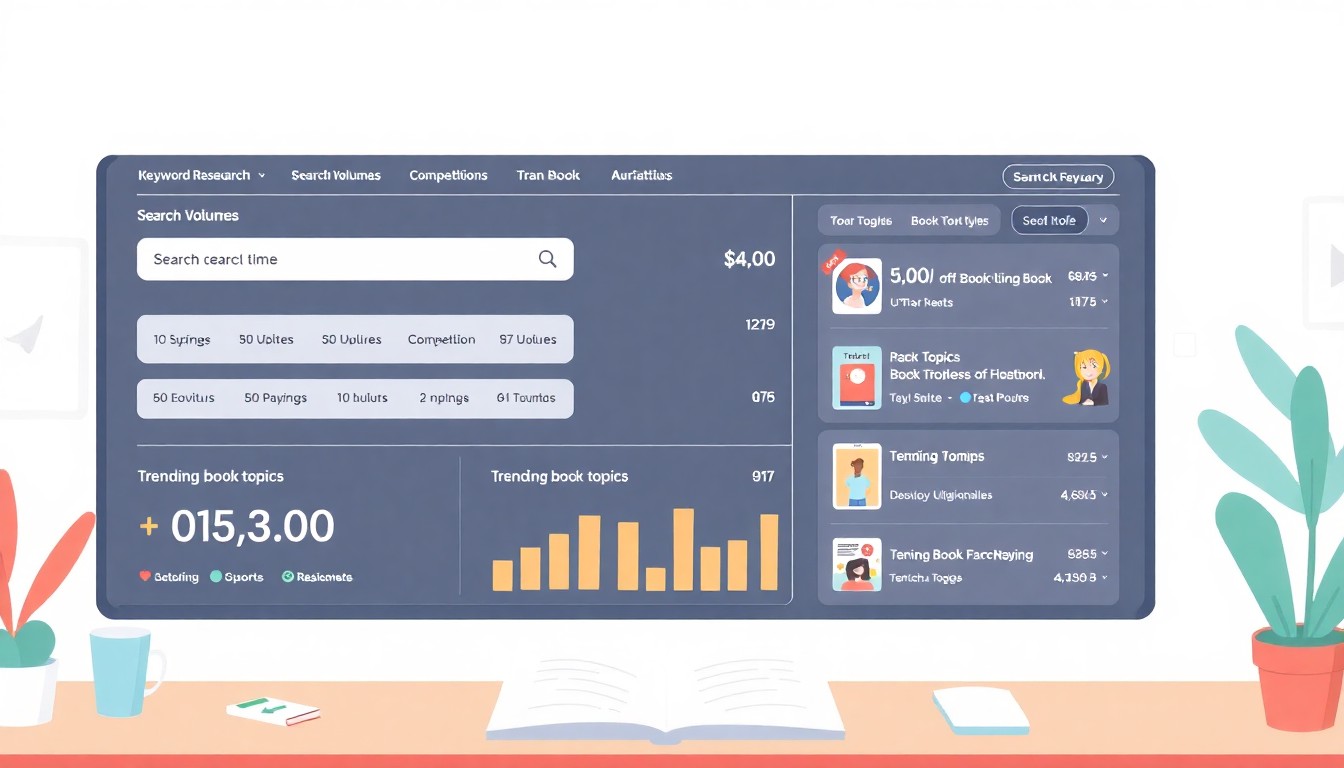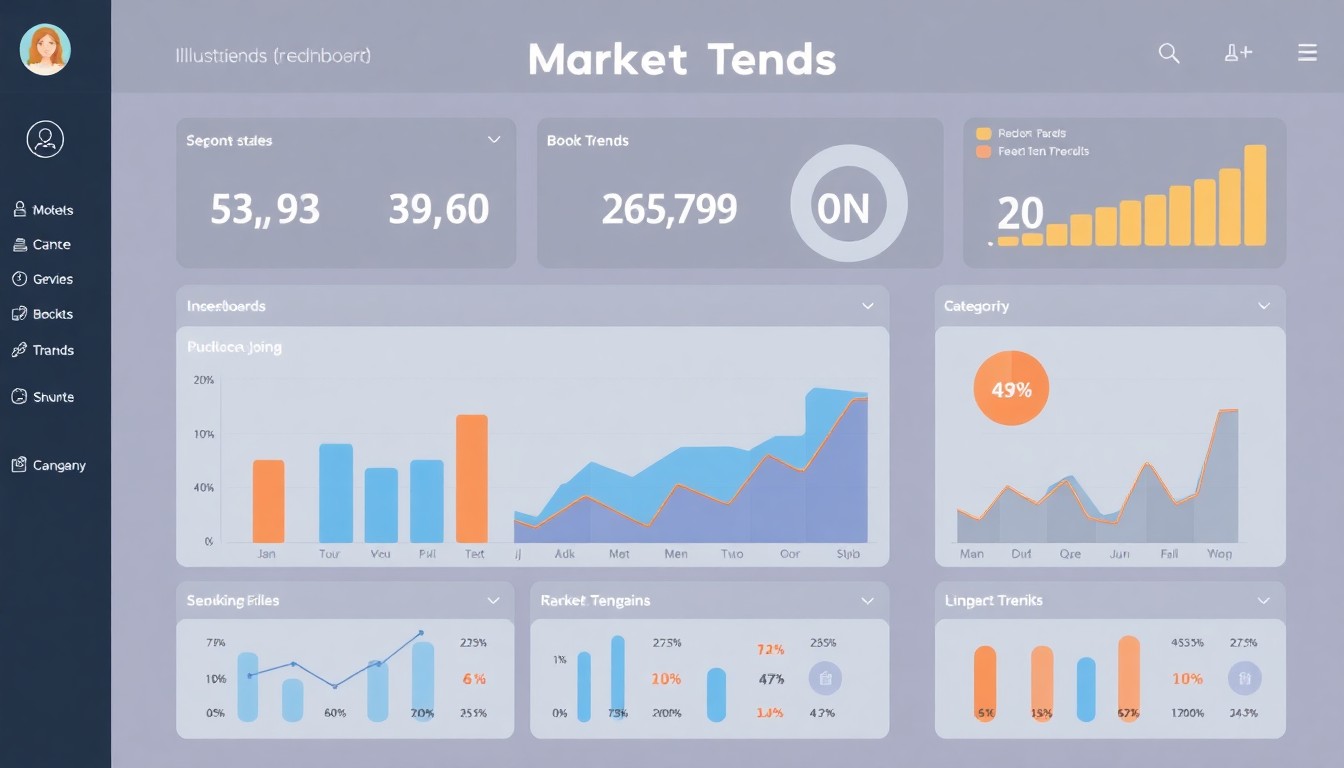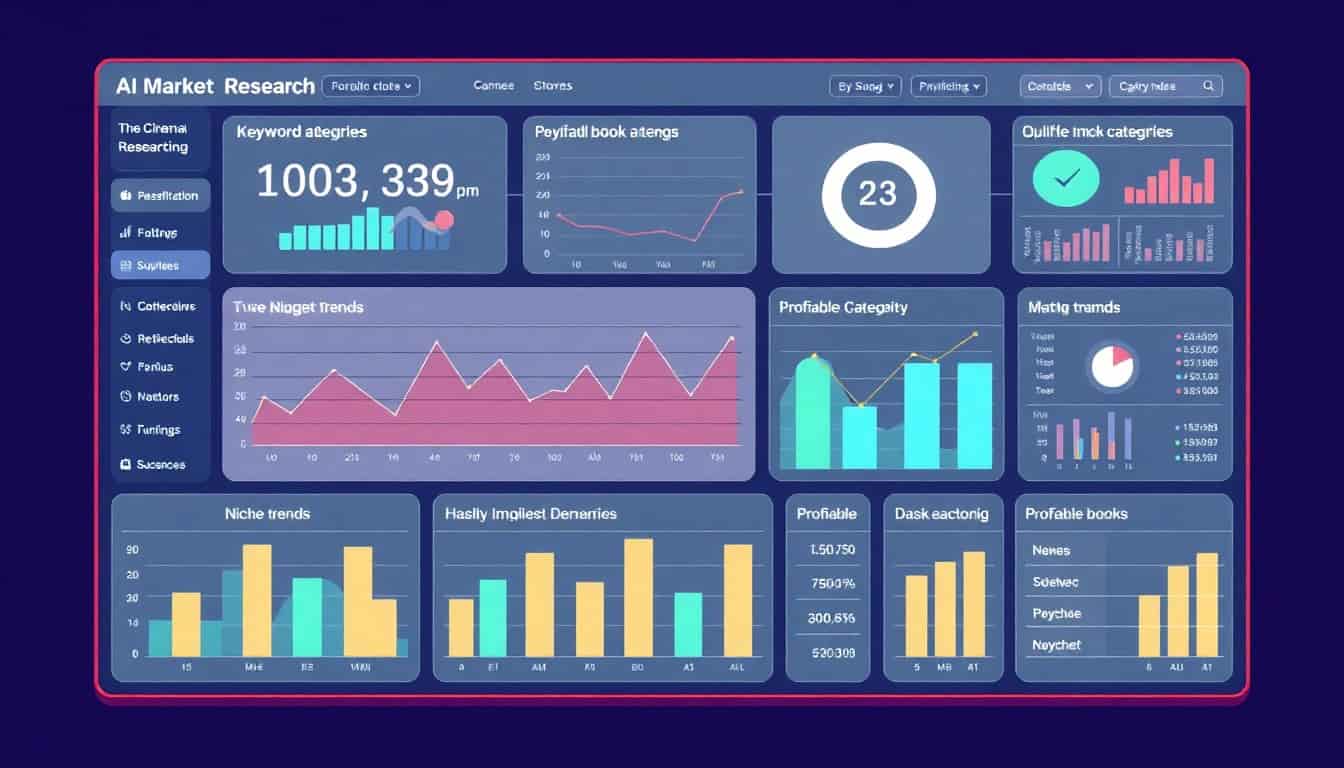Table of Contents
Publishing a book without market research is like opening a store without knowing what customers want. Automateed's AI Market Research Tool gives you data-driven insights to create books people actually want to read—before you invest time and resources in writing.
Discover profitable niches, analyze keyword demand, assess competition, and identify market gaps with AI-powered research. Make informed decisions about what books to create and maximize your chances of success on Amazon KDP and other platforms.
Key Takeaways
- Research profitable book niches before creating content
- Discover trending topics and reader demand with AI analysis
- Analyze keyword search volumes and competition levels
- Identify underserved markets with high opportunity
- Validate book ideas with real market data
- Reduce publishing risk and increase success rate
- Make data-driven decisions for maximum ROI

What is Market Research Tool?
The Market Research Tool is your AI-powered assistant for discovering profitable book opportunities. Instead of guessing what topics might sell, you get real data about reader demand, search volumes, competition levels, and market trends.
Think of it as having a professional market analyst working for you. Enter any topic or niche you're interested in, and the AI analyzes thousands of data points to show you what's working, what's oversaturated, and where the opportunities lie.
This tool is perfect for self-publishers who want to maximize their chances of success. Whether you're writing your first book or your twentieth, starting with solid market research dramatically improves your outcomes.
How Market Research Tool Works
The research process is designed to be simple and fast. Here's exactly how it works:
Step 1: Enter Your Topic or Niche
Start by entering a broad topic area you're interested in exploring. This could be anything from "personal finance" to "dog training" to "vegan cooking." You don't need to be specific yet—the AI will help you narrow down.
The tool accepts natural language, so you can type "I want to write about weight loss" or just enter "weight loss" and the AI understands your intent.
Step 2: AI Analyzes the Market
Once you submit your topic, the AI goes to work analyzing:
- Search Volume Data: How many people search for related terms each month
- Keyword Variations: Related topics and long-tail keywords people use
- Trending Topics: What's currently growing in popularity
- Seasonal Patterns: When demand peaks throughout the year
- Competition Analysis: How many books exist and their quality levels
- Market Gaps: Underserved subtopics with opportunity
The AI processes this data and presents it in an easy-to-understand dashboard with visualizations and recommendations.

Step 3: Review Keyword Opportunities
The tool displays related keywords ranked by opportunity score. Each keyword shows:
- Monthly search volume (how many people are looking for this)
- Competition level (low, medium, or high)
- Trend direction (growing, stable, or declining)
- Opportunity score (AI's recommendation of potential success)
Focus on keywords with decent search volume but lower competition—these are your sweet spots for new books.
Step 4: Analyze Competition
See how many books already exist in your chosen niche and assess their quality. The tool helps you identify:
- Oversaturated Niches: Too many books, hard to stand out
- Underserved Topics: Reader demand but few quality books
- Quality Gaps: Many books exist but they're poorly written or outdated
- Pricing Insights: What successful books in the niche charge

Step 5: Discover Trending Topics
AI identifies emerging topics and seasonal trends. See what's growing in popularity now so you can create timely content that rides the wave of increasing demand.
The tool also shows you seasonal patterns—for example, "tax preparation" peaks in January-March, while "summer fitness" grows in April-May. Time your book launches for maximum impact.

Step 6: Make Informed Decisions
Use all this data to decide:
- What book topic to pursue
- What title and keywords to target
- What subtopics to cover in chapters
- What angle makes your book unique
- When to publish for best results
Create your book with confidence, knowing there's proven demand for your topic.
Who Should Use Market Research Tool?
Self-Publishers and Indie Authors
Don't waste months writing a book nobody wants. Research first, write second. Use market data to validate your book ideas before investing time in creation. Find profitable niches where your expertise can shine without facing overwhelming competition.
New Authors Starting Out
If you're new to publishing and unsure what to write about, market research shows you proven opportunities. Start with niches that have clear demand and manageable competition—set yourself up for success from day one.
Experienced Authors Expanding Catalog
Already published successfully? Use research to identify your next profitable project. Find related niches, discover trending topics in your expertise area, or identify gaps in markets you already serve.
Publishers and Content Businesses
Make data-driven acquisition decisions. Research shows which book topics are worth commissioning, which niches to focus on, and what gaps exist in your current catalog.
Course Creators and Coaches
Creating a companion book for your course or coaching program? Research what subtopics your audience is actively searching for to ensure your book addresses their most pressing needs.
Key Features in Detail
Keyword Search Volume Analysis
See exactly how many people search for topics each month. High search volume indicates strong reader demand. The tool shows monthly searches, search trends over time, and related keyword variations.
Competition Assessment
Understand the competitive landscape before entering a niche. The AI analyzes existing books, their ratings, review counts, and pricing to give you a complete picture of what you're up against.
Trend Discovery
Identify topics growing in popularity before they become oversaturated. Get in early on trending niches and establish authority while competition is still low.
Niche Opportunity Scoring
AI calculates an opportunity score for each niche based on search demand, competition level, monetization potential, and trend direction. Focus your efforts on high-opportunity niches.
Seasonal Pattern Identification
Discover when certain topics peak throughout the year. Plan your book launches to coincide with seasonal demand spikes for better visibility and sales.
Related Topic Suggestions
Find adjacent niches and subtopics you might not have considered. Expand your thinking and discover new opportunities related to your core expertise.
Real-World Use Cases
Finding a Low-Competition Niche: Sourdough Baking
An author interested in baking used Market Research Tool to analyze "bread baking." The tool revealed this niche was highly competitive with hundreds of books. However, drilling down into subtopics, "sourdough starter troubleshooting" had strong search volume but only a few mediocre books. The author created a focused guide solving common sourdough problems and achieved bestseller status in the baking category.
Timing a Book Launch: Tax Preparation
A CPA wanted to write about tax filing. Research showed searches spike 400% in January-March. Instead of publishing in summer, he prepared his book in November and launched in early January, capturing peak demand. The seasonal timing resulted in 5x more sales than a summer launch would have.
Discovering Trending Topics: AI for Small Business
An entrepreneur researching "small business tools" discovered a rapidly growing subtopic: "AI tools for small business." With searches increasing 300% year-over-year but limited quality content, she quickly created a comprehensive guide. Publishing early in a trending niche gave her first-mover advantage.
Avoiding Oversaturated Markets: Weight Loss
A fitness coach initially planned a general weight loss book. Research revealed this niche had 10,000+ competing titles. Drilling deeper, "weight loss for busy professionals" showed strong demand with only 50 quality books. This specific angle let him stand out in a massive market.
International Opportunity: Spanish Language Cookbooks
An author researching cookbook niches discovered that while English-language vegan cookbooks were saturated, Spanish-language versions had high demand but limited supply. She used Automateed's translator to publish bilingual editions, opening an entire new market.
Tips for Effective Book Market Research
1. Start Broad, Then Narrow Down
Begin with a general topic like "fitness" or "productivity," then use the tool to identify specific subtopics with the best opportunity. Don't commit to a niche until you've explored variations and compared opportunities.
2. Look for the Sweet Spot
The ideal niche has moderate-to-high search volume with low-to-medium competition. Avoid both extremes: niches with no demand won't sell, while oversaturated markets make it hard to get noticed.
3. Analyze Top Competitors
Look at the best-selling books in your target niche. What are they doing right? What gaps exist in their content? What complaints appear in their reviews? These insights help you create a superior book that fills market needs.
4. Consider Your Expertise
Research reveals opportunities, but choose niches where you can add value. Your unique perspective, experience, or approach makes your book valuable—combine market opportunity with your strengths.
5. Think Series Potential
The best niches support multiple books. If you find a profitable topic, consider whether you could create a series. "Keto for Beginners," "Keto Meal Prep," and "Keto Desserts" all serve the same audience and cross-promote each other.
6. Check Multiple Platforms
While Amazon KDP is the largest market, don't ignore other opportunities. Some niches perform better on specific platforms or in certain geographic markets. Research helps identify where your book will thrive.
Understanding the Research Data
Search Volume Interpretation
Monthly search volumes indicate demand:
- Under 500 searches: Niche might be too small unless highly profitable per sale
- 500-2,000 searches: Good for specific books with dedicated audiences
- 2,000-10,000 searches: Sweet spot for most self-publishers
- Over 10,000 searches: Large market but expect significant competition
Competition Levels
Competition scoring helps you assess difficulty:
- Low Competition: Under 50 quality books—great opportunity for new authors
- Medium Competition: 50-200 books—need a unique angle or superior quality
- High Competition: 200+ books—requires exceptional quality and marketing
Trend Analysis
Trend directions inform timing:
- Rising Trends: Get in now while competition is building
- Stable Trends: Evergreen topics with consistent demand
- Declining Trends: Avoid unless you can offer something revolutionary
Opportunity Scores
The AI combines all factors into a single score:
- 80-100: Excellent opportunity—high demand, manageable competition
- 60-79: Good opportunity—solid potential with effort
- 40-59: Moderate opportunity—requires unique approach
- Under 40: Challenging—consider alternatives or niche down further
Common Market Research Mistakes to Avoid
Mistake 1: Chasing High Search Volume Only
High search volume seems attractive, but it usually means high competition too. A niche with 50,000 monthly searches and 5,000 competing books is harder than one with 2,000 searches and 30 books.
Mistake 2: Choosing Topics You Know Nothing About
Research might show "cryptocurrency investing" is profitable, but if you don't understand crypto, your book won't be authentic or valuable. Choose profitable niches that align with your knowledge or willingness to learn deeply.
Mistake 3: Ignoring Your Unique Angle
Even in competitive niches, you can succeed with a unique perspective. "Weight loss" is saturated, but "weight loss for shift workers" or "weight loss with autoimmune disease" can work if you have relevant expertise.
Mistake 4: Not Considering Book Length
Some topics naturally require comprehensive treatment ("Complete Guide to Digital Marketing"), while others work better as focused short books ("15-Minute Morning Yoga Routine"). Match your book length to reader expectations in that niche.
Mistake 5: Publishing Without Validating
Research shows opportunity, but validate by checking actual reader reviews. What problems are readers complaining about? What do they wish existing books included? Your book can fill these specific gaps.
Integrating Research with Book Creation
From Research to Outline
Once you identify a profitable niche, use the keyword data to structure your book. Related keywords become chapters, and long-tail variations become subchapters. This ensures your book covers what readers actually want to learn about.
Optimizing Titles and Descriptions
Incorporate high-volume keywords into your book title and description for better discoverability. If research shows "keto meal prep for beginners" has strong search volume, that phrase should appear in your title.
Creating Content That Matches Intent
Research reveals what people are looking for. If searches for "quick vegetarian recipes" far outnumber "gourmet vegetarian cooking," you know readers want simple, fast meals—not complex culinary techniques.
Getting Started with Market Research
Step 1: Brainstorm Topic Ideas
List 5-10 topics you're knowledgeable about or interested in exploring. Don't filter yet—just brainstorm possibilities based on your expertise, hobbies, professional experience, or interests.
Step 2: Research Each Topic
Run each topic through the Market Research Tool. Compare opportunity scores, search volumes, and competition levels. Some topics you're excited about might have poor market potential, while others you hadn't considered deeply might show strong opportunity.
Step 3: Identify Your Best Opportunity
Choose the topic that balances three factors:
- Market opportunity (demand with manageable competition)
- Your expertise or ability to create quality content
- Personal interest (you'll write better about topics you care about)
Step 4: Deep Dive into Your Chosen Niche
Once selected, research deeper. Explore subtopics, related keywords, and specific angles. Build a comprehensive understanding of what readers in this niche want and need.
Step 5: Create Your Book
Use insights from research to inform your book creation. Structure chapters around high-demand subtopics, use researched keywords in your title, and address gaps you identified in competitor books.
Frequently Asked Questions
Our AI analyzes real search data, Amazon rankings, and market trends to provide accurate insights. While no tool predicts success with 100% certainty, data-driven decisions significantly improve your odds compared to guessing. We use multiple data sources to cross-validate insights.
Yes! While Amazon KDP is a primary focus given its market dominance, the tool analyzes general market demand, search trends, and reader interests across all platforms. Insights apply to any publishing platform, social media content, or marketing channel.
Research before starting each new book project. Markets change quickly—what was a great opportunity six months ago might now be saturated. Also do periodic research on your existing niches to spot emerging trends or new subtopics to cover.
No tool can guarantee sales, but research dramatically improves your odds. It helps you avoid obvious mistakes (oversaturated markets, topics with no demand) and identify real opportunities. Success still requires quality content, good cover design, and effective marketing—research just ensures you're building on solid ground.
Yes! Research works for fiction too. Analyze genre popularity, subgenre trends, and reader demand. For example, "cozy mystery with cats" versus "hard-boiled detective" or "paranormal romance" versus "contemporary romance"—data shows which variations have more reader interest.
The AI analysis takes 30-60 seconds per topic. Thorough research on a niche—exploring variations, analyzing competitors, and understanding the market—typically takes 10-15 minutes. This small time investment saves weeks or months of writing books that won't sell.
Low opportunity doesn't mean "don't write"—it means "be strategic." You might niche down further, find a unique angle, target a specific audience segment, or combine it with better opportunities. Sometimes low-opportunity niches work perfectly for specific goals like building authority or serving a dedicated community.
Yes! Save research for different niches and compare them side-by-side. This helps you make informed decisions when choosing between multiple book ideas or planning your publishing calendar for the year.
Conclusion: Publish Smarter, Not Harder
The most successful self-publishers don't just write more books—they write the right books. Market research is the difference between hoping your book finds readers and knowing there's demand before you write a single word.
With Automateed's Market Research Tool, you have professional-grade market intelligence at your fingertips. Discover opportunities, validate ideas, and make data-driven decisions that maximize your publishing ROI.
Don't publish blindly. Research first, create confidently, and succeed consistently. Your next bestseller starts with understanding what readers want—and now you have the tools to find out.



